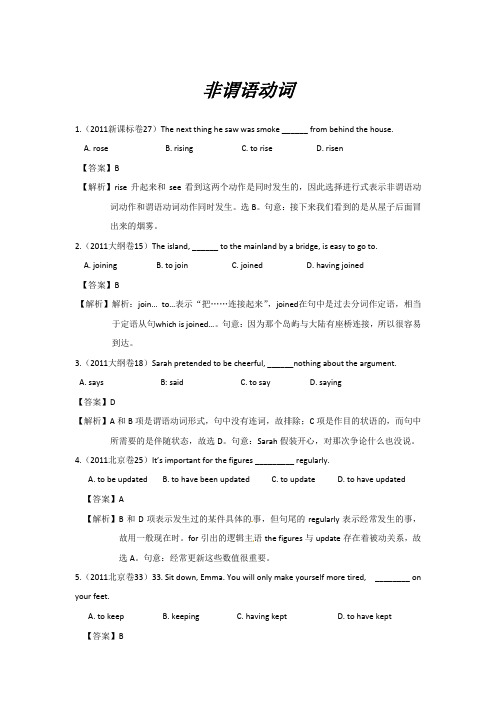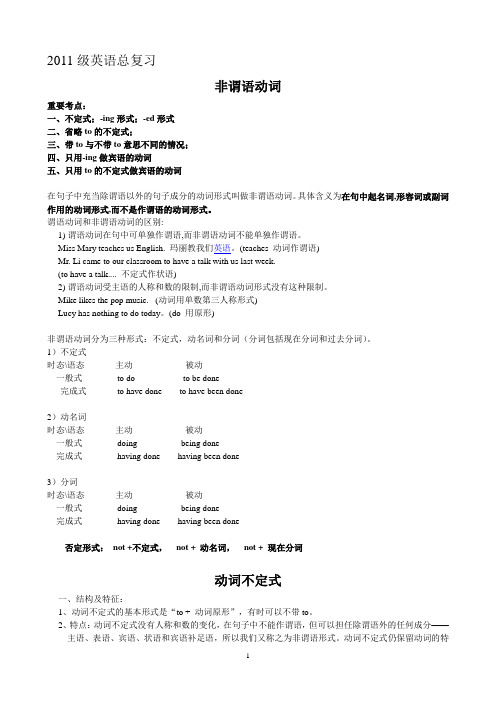2011广东非谓语动词复习
- 格式:ppt
- 大小:1.61 MB
- 文档页数:32

非谓语动词1.(2011新课标卷27)The next thing he saw was smoke ______ from behind the house.A. roseB. risingC. to riseD. risen【答案】B【解析】rise升起来和see看到这两个动作是同时发生的,因此选择进行式表示非谓语动词动作和谓语动词动作同时发生。
选B。
句意:接下来我们看到的是从屋子后面冒出来的烟雾。
2.(2011大纲卷15)The island, ______ to the mainland by a bridge, is easy to go to.A. joiningB. to joinC. joinedD. having joined【答案】B【解析】解析:join… to…表示“把……连接起来”,joined在句中是过去分词作定语,相当于定语从句which is joined…。
句意:因为那个岛屿与大陆有座桥连接,所以很容易到达。
3.(2011大纲卷18)Sarah pretended to be cheerful, ______nothing about the argument.A. says B: said C. to say D. saying【答案】D【解析】A和B项是谓语动词形式,句中没有连词,故排除;C项是作目的状语的,而句中所需要的是伴随状态,故选D。
句意:Sarah假装开心,对那次争论什么也没说。
4.(2011北京卷25)It’s important for the figures _________ regularly.A. to be updatedB. to have been updatedC. to updateD. to have updated 【答案】A【解析】B和D项表示发生过的某件具体的事,但句尾的regularly表示经常发生的事,故用一般现在时。

2011级英语总复习非谓语动词重要考点:一、不定式;-ing形式;-ed形式二、省略to的不定式;三、带to与不带to意思不同的情况;四、只用-ing做宾语的动词五、只用to的不定式做宾语的动词在句子中充当除谓语以外的句子成分的动词形式叫做非谓语动词。
具体含义为在句中起名词,形容词或副词作用的动词形式,而不是作谓语的动词形式。
谓语动词和非谓语动词的区别:1) 谓语动词在句中可单独作谓语,而非谓语动词不能单独作谓语。
Miss Mary teaches us English. 玛丽教我们英语。
(teaches 动词作谓语)Mr. Li came to our classroom to have a talk with us last week.(to have a talk.... 不定式作状语)2) 谓语动词受主语的人称和数的限制,而非谓语动词形式没有这种限制。
Mike likes the pop music. (动词用单数第三人称形式)Lucy has nothing to do today。
(do 用原形)非谓语动词分为三种形式:不定式,动名词和分词(分词包括现在分词和过去分词)。
1)不定式时态\语态主动被动一般式to do to be done完成式to have done to have been done2)动名词时态\语态主动被动一般式doing being done完成式having done having been done3)分词时态\语态主动被动一般式doing being done完成式having done having been done否定形式:not +不定式,not + 动名词,not + 现在分词动词不定式一、结构及特征:1、动词不定式的基本形式是“to + 动词原形”,有时可以不带to。
2、特点:动词不定式没有人称和数的变化,在句子中不能作谓语,但可以担任除谓语外的任何成分——主语、表语、宾语、状语和宾语补足语,所以我们又称之为非谓语形式。

广东高中英语语法难点、要点:非谓语动词的正确用法(一)在英语中,不作句子谓语,而拥有除谓语外其余语法功能的动词,叫做非谓语动词。
非谓语动词有动词不定式(the Infinitive );动名词(the Gerund);此刻分词(the Present Participle );过去分词( the Past Participle)。
1.非谓语动词与谓语动词的同样点有:(1)假如是及物动词都可与宾语连用,比如:They built a garden.They suggested building a garden.(2)都能够被状语修饰:The suit fits him very well.The suit used to fit him very well.(3)都有主动与被动 , “体”式(一般式;进行式;达成式)的变化。
比如:He was punished by his parents.(谓语动词被动语态)He avoided being punished by his parents.(动名词的被动式)We have written the composition. (谓语动词的达成时)Having written the composition, we handed it in. (此刻分词的达成式)(4)都能够有逻辑主语They started the work at once. (谓语动词的逻辑主语)The boss ordered them to start the work.(动词不定式的逻辑主语)We are League members.(谓语动词的主语)We being League member, the work was well done.(此刻分词的逻辑主语)2、非谓语动词与谓语动词的不一样点有:(1)非谓语动词能够出名词作用(如动词不定式和动名词),在句中做主语、宾语、表语。



非谓语动词在句中充当除谓语以外的句子成分的动词形式叫做非谓语动词。
非谓语动词分为三种形式:不定式、动名词和分词(分词包括现在分词和过去分词)不定式一、不定式的作用1、作主语不定式作主语时,谓语用单数。
往往用it 作形式主语,把不定式放在谓语后面。
通常表示某次具体的行为,如:It took us two hours to finish the job. To learn English well is not easy. It is not easy to learn English.It is impossible for us to get there on time.It‘s necessary to discuss the problem with an experienced teacher.It‘s difficult for sb. to do sth It‘s important for sb. to do sthIt‘s kind(good/ friendly/polite/careless 粗心的/rude 粗鲁的/cruel 残酷的/clever 机灵的/foolish /brave)of sb.to do sth It is very kind of you to help us.注意:(1)其他系动词如look, appear等也可用于此句型。
(2)当不定式作主语的句子中又有一个不定式作表语时,不能用It is …to…的句型。
这样的句子,不能用动名词作表语,试比较:It is to negate my own idea to believe him.(错)To teach is to learn.R Teaching is to learn. FTo believe him is to negate my own idea .(对)It is to learn to teach F To teach I slearning. FThe chair looks rather hard,but it is very comfortable to sit on. Sit/ be seat/ be sat on F如果不定式为不及物动词,漆后面应有必要的介词(3)It is+ adj. of / for sb. to do sth. 结构中,当不定式的逻辑主语和前面的形容词可以构成系表结构时,用of, 否则用for.1)for sb. 用于easy, hard, difficult, interesting, impossible 表示客观形式的形容词It‘s very hard for him to study two languages.2) of sb. good, kind, nice, clever ,foolish, right.表示主观形式的形容词It‘s very kind of you to help me.2、作宾语(1)动词+不定式。
非谓语动词非谓语动词是语法填空的必考考点,每年高考至少有1道题。
不仅如此,掌握非谓语动词的基本用法,对增强书面表达的文采和提高阅读理解能力都有明显的作用。
首先,我们回顾一下非谓语动词的语法功能(在句中充当何种成分):现在,我们简要回顾其主要考点:考点1:作主语表示一般的、泛指的或习惯性的行为用-ing形式;表示具体的、一次性的或将来的动作用不定式。
考点2:作表语(1) 动名词和不定式作表语说明主语的具体内容。
(2)分词作表语则说明主语的性质,像puzzling, surprising, exciting等-ing分词表示“令人……的(事物)”;像puzzled, surprised, excited等-ed分词表示“(人)感到……的”。
考点3:作宾语(1)有些动词只能用不定式作宾语。
如refuse, expect, promise, decide, offer, pretend等。
(类似动词和短语动词还有哪些?请补上)(2)有些动词只能用动名词作宾语。
如:keep, allow, finish, enjoy, mind, practice, avoid, admit, advise, consider, imagine, appreciate, escape, suggest等。
(类似动词和短语动词还有哪些?请补上)(3) 在表示“需要”的need, want和require等后用-ing形式的主动形式表示被动意义,也可用不定式的被动式。
(4)在forget, remember, regret, mean, try等动词后既可接动名词,也可接不定式,但意义差别较大。
(5)在介词之后用动名词作宾语。
注意to是介词的短语,如be /get used to, be accustomed to(习惯于), contribute … to …, devote oneself to /be devoted to, get down to, look forward to 等。